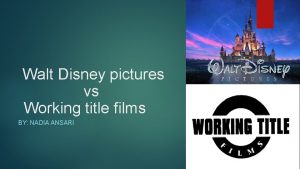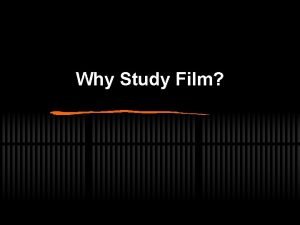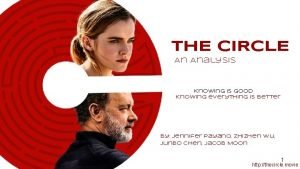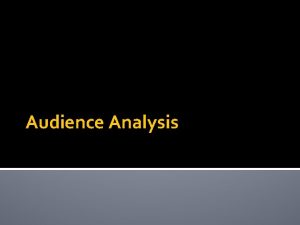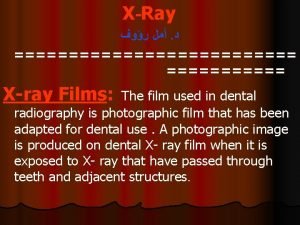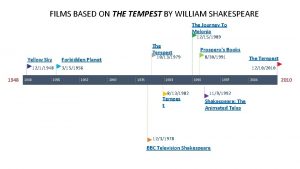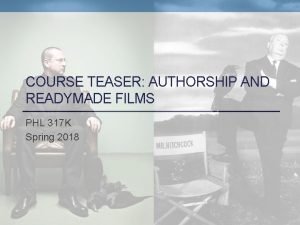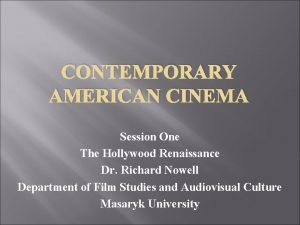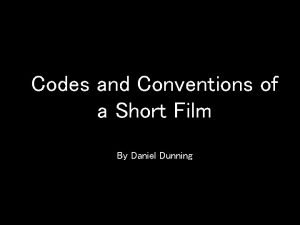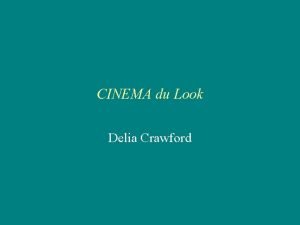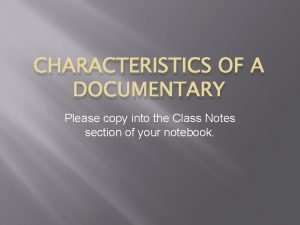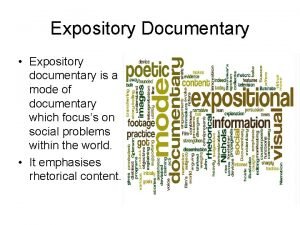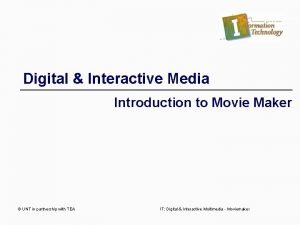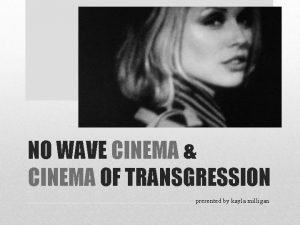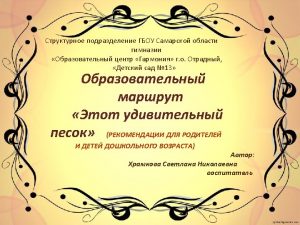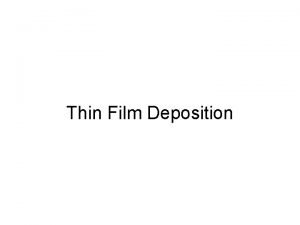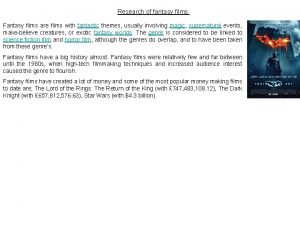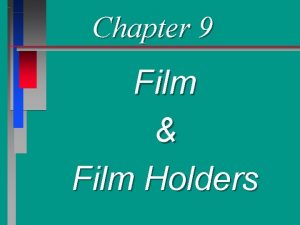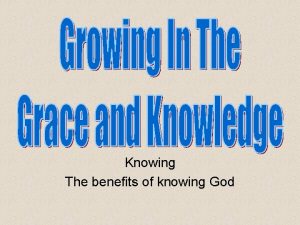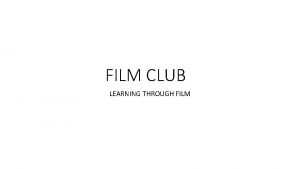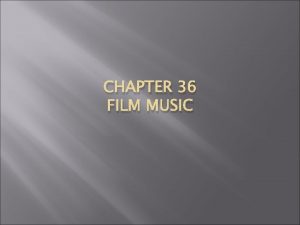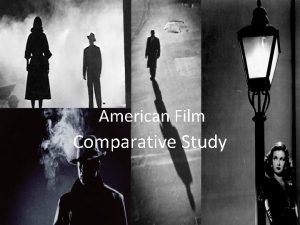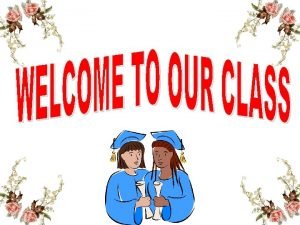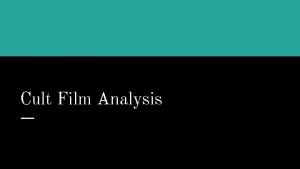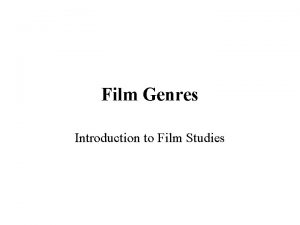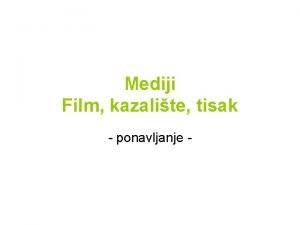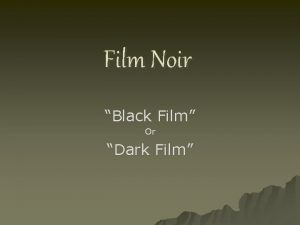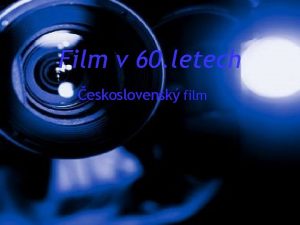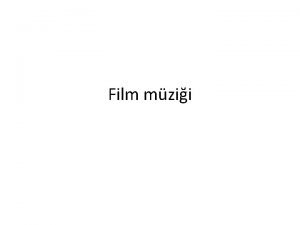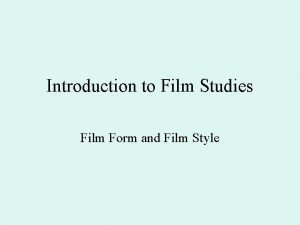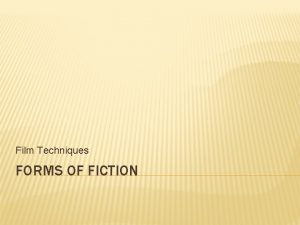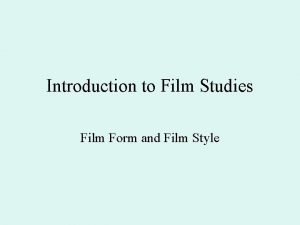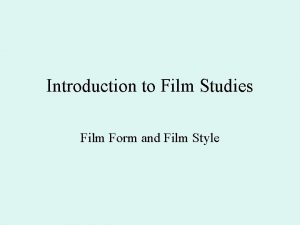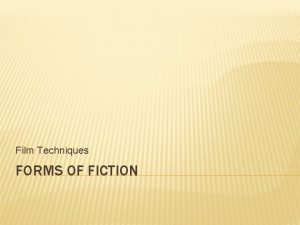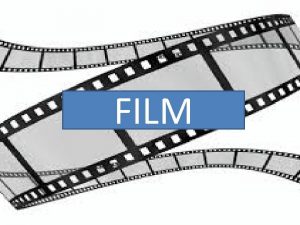Why Study Film Knowing how to analyze films



























- Slides: 27

Why Study Film?

Knowing how to analyze films and build thoughtful interpretations = More enjoyment

Our Goal § Identify the major elements of film art § Recognize the way those elements work together to produce meaning § Develop the skills necessary to interpret what we’re being told (sold? )

What is a movie? • A series of still photos shown quickly to simulation motion • Frame rate • Hurt Locker Phantom footage • A type of communication • A form of popular entertainment • A narrative that tells a story • This “telling” is affected by cultural differences and the era in which it was produced.

Communication & Culture

Communication • SUCCESSFUL transmission of a message from a source to a receiver • Must be sharing of meaning • Response, or feedback • Two types • Interpersonal • Mass

Interpersonal vs. Mass Comm So what’s the difference? • Number of audience members? • Feedback? Is it immediate feedback? • Known audience vs unknown? • Use of a technical or mechanical device? • Gatekeepers?

Communication Model • Who • Says what • To whom • Though what channel • With what effect

Communication Model

What is Culture? ü Learned behavior of a social group. ü Historically transmitted pattern of meaning. ü Uses symbols to communicate knowledge. ü How we make sense of our lives. Communication is required for culture to exist.

Functions and Effects of Culture • Provides useful guidelines for behavior. • In pluralistic society both dominant and bounded cultures exist. • Cultural values can be contested. • It’s fluid, ever changing. • Culture can unite or divide.

Viewer Expectations ü Expected patterns ü Viewers harbor essential expectations concerning a film’s form and organization ü Viewers must be alerted to these expected patterns in order to fully appreciate the significance of deviations ü But where do these expectations come from? ü Prior experience (we recognize conventions) 12

Manipulating expectations (sound) § The Shining § Forrest Gump

Conventions ü The conventions of a genre are the elements that commonly occur in such films. ü Sometimes they’re called “codes. ” ü They may include things like characters, situations, settings, props, themes and events. ü The conventions of the science-fiction genre is that the story often includes robots, aliens, time-travel or genetic manipulation. ü Trope – tends to be literary, figurative language (metaphor, simile, personification, irony, hyperbole, pun). 14

History of Film

Precursors of Film § Persistence of Vision § 100 A. D. – Ptolemy discovered that the human eye retains an image on the retina for 1/24 of a second. § Phi Phenomenon & critical flicker fusion § If light is pulsed at a certain speed (24 fps), the illusion is continuous light. So, when pictures are flashed in quick succession, we perceive them as moving. § Pinhole cameras/camera obscura § China, 390 BC & Persia, 945 AD

The Beginnings § Film language (think language + culture!) § People had to become film literate. It was like being in a foreign country where you don’t speak the language. § Had to understand cinematic alterations of time and space; how images and sound combine to create meaning; camera angles.

The Beginnings (con’d) • Late 1800 s • Industrial revolution • Immigration • Film language (think language + culture!) • People had to become film literate. It was like being in a foreign country where you don’t speak the language. • Had to understand cinematic alterations of time and space; how images and sound combine to create meaning; camera angles.

Precursors of Film 1800’s Europe § Phonotrope § Zoetrope

The Early Years - Pioneers

The Early Years - Pioneers § Eadweard Muybridge § Developed photography to reveal motion. § Wager by Ca. governor Stanford to show all 4 legs of a horse were in the air at one time. § “Bullet-time” – Matrix slo-mo technique which used the basic principals of Muybridge’s “The Horse in Motion. ”

The Early Years - Pioneers § Eadweard Muybridge

The Early Years - Pioneers § Thomas Edison § After meeting Muybridge, he set out to invent a projector. As always with Edision, his assistant, Dickson, did. § Dickson also invented a better way to film – celluloid.

The Early Years - Pioneers § Thomas Edison § Black Maria (N. J. ) – motion picture studio (really just a box that could be rotated to have enough light.

The Early Years - Pioneers § Thomas Edison § These completed films were shown in a kinetoscope. i. Pod 0. 0

The Early Years - Pioneers § Lumiere Brothers § They were considered the first to exhibit moving pictures – 1895 § They thought it was “an invention without any future” § Films such as Workers Leaving the Station, Arrival of a Train at the Station

The Early Years - Pioneers § George Melies – the “cinemagician” § First to use the “stop trick, ” multiple exposures, time lapse photography and dissolves. § Still using proscenium staging. § Trip to the Moon § And this
 Working titles films
Working titles films How to analyze film
How to analyze film The circle analysis
The circle analysis Not knowing is worse than knowing
Not knowing is worse than knowing Hey hey bye bye
Hey hey bye bye Why is knowing your learning style important
Why is knowing your learning style important Slipper or guide bearing
Slipper or guide bearing Example of problems in community
Example of problems in community How do you analyze your audience
How do you analyze your audience Don't ask why why why
Don't ask why why why Dental xray films
Dental xray films Thin films testing
Thin films testing The tempest animated tales
The tempest animated tales Readymade films
Readymade films Hollywood renaissance films
Hollywood renaissance films Codes and conventions of short films
Codes and conventions of short films Delia crawford
Delia crawford Characteristics of documentary films
Characteristics of documentary films Bulge test thin films
Bulge test thin films Expository mode of documentary
Expository mode of documentary Ftd newsgroup
Ftd newsgroup Interactive movie maker
Interactive movie maker Advantages of multi camera production
Advantages of multi camera production No wave film
No wave film Yandex ru video
Yandex ru video Yandex film b****
Yandex film b**** My hobby is watching films
My hobby is watching films Alternative films
Alternative films
